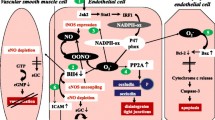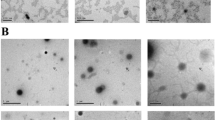Abstract
Renal ischemia is of clinical interest because of its role in renal failure and also renal graft rejection. To evaluate the effect of the combination of N-acetylcysteine (NAC), a potent antioxidant, sodium nitroprusside (SNP), a nitric oxide donor, and phosphoramidon (P), an endothelin converting enzyme inhibitor, on tissue protection against ischemia-reperfusion injury, we studied the biochemical and morphological changes due to 90 min of renal ischemia-reperfusion in the rat model. Ninety min of ischemia caused very severe injury and the animals could not survive after 4 days without any treatment. Whereas, animals in the treated groups survived i.e. the NAC group (25%), NAC + SNP group (43%) and in the NAC + SNP + P group (100%), 2 weeks after 90 min of ischemia. A significant increase in the serum levels of creatinine and urea nitrogen was shown in the untreated group and to a much lesser extent in the treated group, especially in the NAC + SNP + P group. The protective effect was also supported by light microscopic studies on renal tissue sections. We also measured the activities of antioxidant enzymes in tissue homogenates. With the exception of Mn-superoxide dismutase, the activities of antioxidant enzymes (catalase, glutathione peroxidase, CuZn-superoxide dismutase) were decreased in the untreated kidney. The administration of NAC alone and NAC + SNP protected against the loss of activities. Treatment with a combination of NAC, SNP and P showed a synergistic effect as evidenced by the best protection. These results suggest that pre-administration of a combination of antioxidant (NAC) with endothelin derived vasodilators (sodium nitroprusside and Phosphoramidon) attenuates renal ischemia-reperfusion injury, e.g. in donor kidney for transplantation, by protecting cells against free radical damage.
Similar content being viewed by others
References
Reimer KA, Ganote CE, Jennings RB: Alterations in renal cortex following ischemic injury. 3. Ultrastructure of proximal tubules after ischemia or autolysis. Lab Invest 26: 347-363, 1972
Glaumann G, Glaumann H, Trump BF: Studies of cellular recovery from injury. III. Ultrastructural studies on the recovery of the pars recta of the proximal tubule (P3 segment) of the rat kidney from temporary ischemia. Virchows Arch B Cell Pathol 25: 281-308, 1977
Dobyan DC, Nagle RB, Bulger RE: Acute tubular necrosis in the rat kidney following sustained hypotension: Physiologic and morphologic observations. Lab Invest 37: 411-412, 1977
Venkatachalam MA, Bernard DB, Donohoe JF, Levinsky NG: Ischemic damage and repair in the rat proximal tubule: Differences among the S1, S2, and S3 segments. Kidney Int 14: 31-49, 1978
Brezis M, Rosen S, Silva P, Epstein FH: Selective vulnerability of the medullary thick ascending limb to anoxia in the isolated perfused rat kidney. J Clin Invest 73: 182-189, 1984
Shanley PF, Rosen MD, Brezis M, Silva P, Epstein FH, Rosen S: Topography of focal proximal tubular necrosis after ischemia with reflow in the rat kidney. Am J Pathol 122: 462-468, 1986
Weigele G, Brandis M, Zimmerhackl LB: Improvement of liver function in a paediatric patient with biliary cirrhosis after triple immunosuppression with Mycophenolate following renal transplantation. Nephrol Dialysis Transplant 13: 1158-1167, 1998
Lieberthal W, Levine JS: Mechanisms of apoptosis and its potential role in renal tubular epithelial cell injury. Am J Physiol 40: F477-F488, 1996
Saikumar P, Dong Z, Weinberg JM, Venkatachalam MA: Mechanisms of cell death in hypoxia/reoxygenation injury. Oncogene 17: 3341-3349, 1998
Takeda M, Shirato I, Kobayashi M, Endou H: Hydrogen peroxide induces necrosis, apoptosis, oncosis and apoptotic oncosis of mouse terminal proximal straight tubule cells. Nephron 81: 234-238, 1999
Bonventre JV: Mechanisms of ischemic acute renal failure. Kidney Int 43: 1160-1178, 1993
Johnson KJ, Weinberg JM: Postischemic renal injury due to oxygen radicals. Curr Opin Nephrol Hypertens 2: 625-635, 1993
Paller MS: The cell biology of reperfusion injury in the kidney. J Invest Med 42: 632-639, 1994
Kerhrer J: Free radicals as mediators of tissue injury and disease. Crit Rev Toxicol 32: 21-48, 1993
Nath KA, Paller MS: Dietary deficiency of antioxidants exacerbates ischemic injury in the rat kidney. Kidney Int 38: 1109-1117, 1990
Kehrer J: Free radicals as mediators of tissue injury and disease. Crit Rev Toxical 23: 21-48, 1993
Bayati A, Kallskog O, Wolgast M: The long-term outcome of postischaemic acute renal failure in the rat. I. A functional study after treatment with SOD and sucrose. Acta Physiol Scand 138: 25-33, 1990
Singh I, Gulati S, Orak JK, Singh AK: Expression of antioxidant enzymes in rat kidney during ischemia-reperfusion injury. Mol Cell Biochem 125: 97-104, 1993
Dobashi K, Ghosh B, Orak JK, Singh I, Singh AK: Kidney ischemiareperfusion: modulation of antioxidant defenses. Mol Cell Biochem 205: 1-11, 2000
Sela S, Shasha SM, Mashiach E, Haj M, Kristal B, Shkolnik T: Effect of oxygen tension on activity of antioxidant enzymes and on renal function of the postischemic reperfused rat kidney. Nephron 63: 199-206, 1993
Yoshioka T, Homma T, Meyrick B, Takeda M, Moore-Jarrett T, Kon V, Ichikawa I: Oxidants induce transcriptional activation of manganese superoxide dismutase in glomerular cells. Kidney Int 46: 405-413, 1994
Yoshioka T, Bills T, Moore-Jarrett T, Greene HL, Burr IM, Ichikawa I: Role of intrinsic antioxidant enzymes in renal oxidant injury. Kidney Int 38: 282-288, 1990
Castillo M, Toledo-Pereyra LH, Shapiro E, Guerra E, Prough D, Frantzis P: Protective effect of allopurinol, catalase, or superoxide dismutase in the ischemic rat liver. Transplant Proc 22: 490-491, 1990
Greenwald RA: Superoxide dismutase and catalase as therapeutic agents for human diseases. A critical review. Free Rad Biol Med 8: 201-209, 1990
Reilly PM, Schiller HJ, Buckley JB: Pharmacologic approach to tissue injury mediated by free radicals and other reactive oxygen metabolites. Am J Surg 161: 488-503, 1991
Senga S, Onituka A, Hirose H, Yamamoto K, Niwa K: Protective effect of liposomal encapsulated superoxide dismutase on ischemically injured liver in the rat. Transplant Proc 22: 2025-2026, 1990
Shanley PF, White CW, Avraham KB, Groner Y, Burke TJ: Use of transgenic animals to study disease models: Hyperoxic lung injury and ischemic acute renal failure in 'high SOD' mice. Renal Failure 14: 391-394, 1992
Ahn KY, Mohaupt MG, Madsen KM, Kone BC: In situ hybridization localization of mRNA encoding inducible nitric oxide synthase in rat kidney. Am J Physiol 267: F748-F757, 1994
Schwartz D, Mendonca M, Schwartz I, Xia Y, Satriano J, Wilson CB, Blantz RC: Inhibition of constitutive nitric oxide synthase (NOS) by nitric oxide generated by inducible NOS after lipopolysaccharide administration provokes renal dysfunction in rats. J Clin Invest 2: 439-448, 1997
Noiri E, Peresleni T, Miller F, Goligorsky MS: In vivo targeting of inducible NO synthase with oligodeoxynucleotides protects rat kidney against ischemia. J Clin Invest 97: 2377-2383, 1996
Koeppel TA, Thies JC, Lehmann T, Gebhard MM, Herfarth C, Otto G, Post S: Improvement of hepatic microhemodynamics by N-acetylcysteine after warm ischemia. Eur Surg Res 28: 270-277, 1996
Singh AK, Dobashi K, Singh I, Orak JK: Preconditioning with N-acetylcysteine protects structure/function of kidney against ischemia/reperfusion injury. Adapt Biol Med 2: 303-309, 1999
Singh AK, Dobashi K, Orak JK, Singh I: N-acetylcysteine attenuates ischemia-reperfusion injury: Evidence of diminished oxidative stress with improved antioxidant enzyme defense systems. 2nd Int Symp Antioxidants and Free Rad Health Dis (in press)
Lopez-Neblina F, Toledo-Pereyra LH, Mirmiran R, Paez-Rollys AJ: Time dependence of Na-nitroprusside administration in the prevention of neutrophil infiltration in the rat ischemic kidney. Transplantation 61: 179-183, 1996
Garcia-Criado FJ, Eleno N, Santos-Benito F, Valdunciel JJ, Reverte M, Lozano-Sanchez FS, Ludena MD, Gomez-Alonso A, Lopez-Novoa JM: Protective effect of exogenous nitric oxide on the renal function and inflammatory response in a model of ischemia-reperfusion. Transplant 66: 982-990, 1998
Bird JE, Webb ML, Wasserman AJ, Liu ECK, Giancarli MR, Durham SK: Comparison of a novel ETA receptor antagonist and phosphoramidon in renal ischemia. Pharmacology 50: 9-23, 1995
Vemulapalli S, Chiu PJ, Chintala M, Bernardino V: Attenuation of ischemic acute renal failure by phosphoramidon in rats. Pharmacol 47: 188-193, 1993
Baudhuin P, Beaufay H, Rahman-Li Y, Sellinger OZ, Watliaux R, Jacques P, De Duve C: Tissue fractionation studies. Intracellular distribution of monoamine oxidase, aspartate aminotransferase, alanine aminotransferase, D-amino acid oxidase and catalase in rat-liver tissue. Biochem J 92: 179-184, 1964
Beutler E, Blume KG, Kaplan JC, Lohr GW, Ramot B, Valentine WN: International Committee for Standardization in Haematology: Recommended methods for red-cell enzyme analysis. Br J Haematol 35: 331-340, 1977
Spitz DR, Oberley LW: An assay for superoxide dismutase activity in mammalian tissue homogenates. Anal Biochem 179: 8-18, 1989
Pahan K, Smith BT, Singh AK, Singh I: Cytochrome P-450 2E1 in rat liver peroxisomes: Downregulation by ischemia/reperfusion-induced oxidative stress. Free Rad Biol Med 23: 963-971, 1997
Singh I, Pahan K, Khan M, Singh AK: Cytokine-mediated induction of ceramide production is redox-sensitive. Implications to proinflammatory cytokine-mediated apoptosis in demyelinating diseases. J Biol Chem 273: 20354-20362, 1998
Furlong B, Henderson AH, Lewis MJ, Smith JA: Endothelium-derived relaxing factor inhibits in vitro platelet aggregation. Br J Pharmacol 90: 687-692, 1987
Radomski MW, Palmer RMJ, Moncada S: Comparative pharmacology of endothelium-derived relaxing factor, nitric oxide and prostacyclin in platelets. Br J Pharmacol 92: 181-187, 1987
Radomski MW, Palmer RMJ, Moncada S: The anti-aggregating properties of vascular endothelium: Interactions between prostacyclin and nitric oxide. Br J Pharmacol 92: 639, 1987
Kubes P, Suzuki M, Granger DN: Nitric oxide: An endogenous modulator of leukocyte adhesion. Proc Natl Acad Sci USA 88: 4651-4655, 1991
Johnson III G, Tsao PS, Lefer AM: Cardioprotective effects of authentic nitric oxide in myocardial ischemia with reperfusion. Crit Care Med 19: 244-252, 1991
Myers SI, Hernandez R, Castaneda A: Possible role for oxygen free radicals in the regulation of renal nitric oxide synthesis and blood flow. Am J Surg 169: 604-608, 1995
Author information
Authors and Affiliations
Rights and permissions
About this article
Cite this article
Dobashi, K., Singh, I., Orak, J.K. et al. Combination therapy of N-acetylcysteine, sodium nitroprusside and phosphoramidon attenuates ischemia-reperfusion injury in rat kidney. Mol Cell Biochem 240, 9–17 (2002). https://doi.org/10.1023/A:1020629020443
Issue Date:
DOI: https://doi.org/10.1023/A:1020629020443




